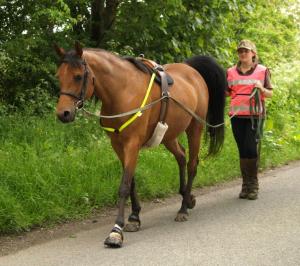I love a recent quote from horse lover Pip Richardson-Jones, who recently moved her two horses from a shod regime to a barefoot regime, using hoof boots when she exercises her horses, Newton’s Comet and Shiny Jack Vegas. *Great names Pip*!
“First time out [in the boots] they bounced up the road with a great deal of showing off. It was a job to maintain a legal speed on the road and they didn’t want to go home! Sometimes riding Jack in his iron shoes felt like riding a bicycle with a buckled wheel.”
Lucky Comet and Jack are now proud owners of the Trail barefoot boots – check out Trelawne’s website (see below) for info. In the mean time, here’s an article by my Mum, Lucy Nicholas, of Trelawne Equine, distributors of barefoot boots, in July’s Local Rider mag (in the Sth East of the UK)!
Grounded!!
Spring 2011 brought us glorious sunshine in the UK – but the lack of rain has meant the ground is very hard, which can lead to equine problems such as solar bruising and joint conditions linked to concussive forces. Many horses and ponies are feeling sore and ‘footy’ at this time of year – but instead of resting your horse or drastically adapting your riding regime, is now the time to consider ditching horse shoes for a more natural approach?
Many experts believe that horse shoes can potentially increase concussive damage, which is a considerable issue when the ground is hard, because shoes hold the frog off the ground. Thus, shoes reduce blood circulation through the hoof and are said to contribute to physiological damage to the supporting limbs and structures.
Many barefoot advocates use horse boots, to protect their horses’ feet in certain circumstances. Mike Chawke of Ireland’s Little Farm Stud, an RF(BngC), MF(IMFA), CE-F qualified farrier, is not convinced that all equines need nailed-on shoes. “Why not leave your animal in its natural state and simply fit hoof boots when they ride?” Mike says.
A new barefoot advocate
Pip Richardson-Jones recently moved her two horses from a shod regime to a barefoot regime, using hoof boots when she exercises and trains her two horses.
“First time out in hoof boots, both Newton’s Comet and Shiny Jack Vegas bounced up the road with a great deal of showing off, and tails in the air – they must feel great – so comfortable after the hard iron [horse shoes],” Pip explains. “It was a job to maintain a legal speed on the road and they didn’t want to go home!
“Second time out, we tried a pretty varied route with different surfaces, hills and rocks, and the horses were just as comfortable – no problems whatsoever, and we even finished by having a race with our greyhound.”
‘Sometimes riding Jack in his iron shoes felt like riding a bicycle with a buckled wheel..’
“The hoofboots we chose were the EasyCare Trail boots, and we have used them several times now – from the first step out, both Comet and Jack are moving a lot more freely; in fact, sometimes riding Jack in his iron shoes felt like riding a bicycle with a buckled wheel. He was clearly uncomfortable, but there was an instant change with the hoof boots.”
Many owners are now considering the barefoot regime, just like Pip, and are reading all the fascinating information available relating to the benefits of barefoot hoof care. For example, horse shoes are also said by many experts to load excess weight on the hoof wall; the greater the load, the worse the blood flow throughout the hoof capsule. Barefoot advocates maintain that by taking the horse’s shoes off, the frog is no longer held off the ground, so the load is relieved by transferring some of the load to the horse’s sole. Because solar loading appears to promote blood flow through the foot, this promotes a strong, healthy hoof – many owners of barefoot horses cannot believe how much ‘freer’ and less ‘footy’ their horses are once they have made the transition to barefoot.
Katie-Marie Palmer helps with a horse called Remi, a mare that also recently made the transition from shod to bare in EasyCare Trail boots, with the addition of EasyCare Comfort Pads inside them; the pads offer added shock absorption for when you’re riding on hard, concussive surfaces. “Remi started landing ‘heel first’ as soon as we put her in the boots, which was great as she had been very much ‘toe first’ when shod. We cannot rate the boots highly enough,” Katie-Marie says.
Visit www.trelawneequine.co.uk or call Trelawne Equine on 0844 257 8585.
Visit http://www.facebook.com/TrelawneEquine to join in regular discussions about hoofcare, whether shod or barefoot.
Tags: barefoot boots, barefoot hoof care, barefoot horse, barefoot trimmer, competition, horse shoes, horseshoe, natural horse care









